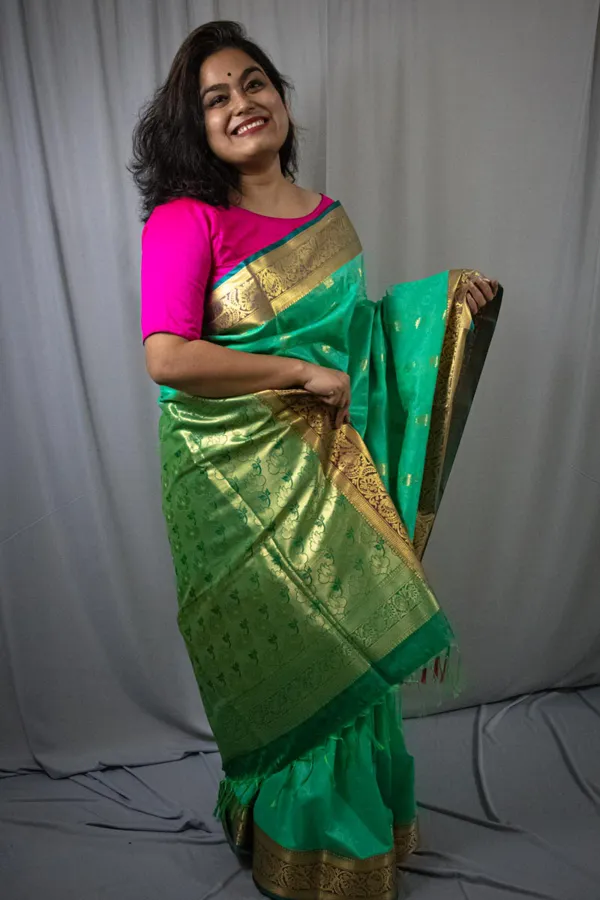Mysore silk is produced by the Karnataka Silk Industries Corporation Limited (KSIC). The company was founded around 1912 by the then Maharaja of Mysore, Sri Nalvadi Krishnaraja Wodeyar IV. The story goes something like that the Maharaja had gone to Britain to be a part of the Queen Victoria’s Silver Jubilee celebration. There he saw the machine-made silk fabrics that the British royalties adored and was taken in by them. He got inspired and went on to order 32 power looms from Switzerland and began the first-ever machine-made silk sarees in India that we know now.
India produces about 20000 metric tons of mulberry silk and Karnataka alone manufactures about 9000 metric tons of mulberry silk, contributing to about 45% of the country’s total production. The production majorly is done in the Mysore district of Karnataka.
History of Mysore Silk
In between 1780 – 1790 AD, Tipu Sultan initiated the growth of the silk industry in the Kingdom of Mysore. But the reason why Mysore silk is still so popular is due to the quality of the fabric. These sarees are made with 100% fine silk and pure zari (65% silver and 0.65% pure gold).
The Art and the Process of Mysore Silk
Initially, the silk fabrics were manufactured only for the royal families and were used to ornament their armed forces. After Independence, the silk weaving factory was taken over by the Mysore State Sericulture Department. It was handed over to KSIC, a Government Industry of Karnataka in 1980.
Procuring Raw Materials
- The Mysore silk factory that is mainly responsible for the silk weaving and distribution of silk products is located in the heart of Mysore and is spread over acres of land.
- Ramanagara district in Karnataka is the main source of silk for this factory. It is also considered to be Asia’s largest market for silk cocoons. Every day, farmers from various parts of this district market their silk cocoons.
- KSIC officials who have expertise in Mysore silk handpick the silk cocoons at this market every day as a part of the government bidding process. These are then sent to T.Narasipura, where the factory manufacturing the raw silk is located.
What is the Production Process of Mysore Silk?
- These cocoons on reaching the raw silk manufacturing factory, go through many processes to extract threads. These threads are then converted into thread rolls and sent to the weaving factories in Mysore.
- They go through the winding and wefting process. The yarns are ready to be woven once the winding is done.
- There are two types of looms used for the weaving process, the dobby loom and the jacquard loom.
- It takes about four hours to make one saree.
- The next step is degumming the saree as it helps smoothen it.
- The saree is then sent for dyeing and washing.
- The sarees when are semi-dry, are sent for steam ironing on massive machines.
- Post ironing, the saree is cut to the desired length. They are usually 5.5 metres long. The blouse piece is also attached to it.
- They make exquisite designs on the pallu.
- The sarees are given a Unique Identification code to check and assure their authenticity.
Motifs
Usually, a zari border is the main embellishment of these sarees. But to make them more appealing, motifs like mango butis and floral border are also woven on the Mysore silk sarees. Bandhani designs and Kasuti embroidery is also seen on these sarees.
Colours
The sarees come in a single colour with a golden border and zari. Traditionally, they were made in the hues of green, orange and red. Nowadays, they are also available in elephant grey, coffee brown and lilac shade.
How to Identify Original Mysore Silk saree?
- Every Mysore Silk Saree has a unique code embroidered at the corner that tells the history, manufacturing details, hours spent on the making and the wages received by the weavers of the saree.
- One can do the rub test. Rub the fabric in between the hands and if one feels the warmth, then it’s original silk. Fake silk won’t give the same feeling.
What is the Price Range of Mysore Silk Sarees?
Depending on the work done and time spent on it, an original Mysore silk saree can range anywhere between Rs 3000 to 7000 or higher approximately. When going for an authentic KSIC pure silk saree, the price range will begin from Rs 15000 and above for a plain saree with a simple zari border. The more intricate and expensive ones can even go up to Rs 200000 or higher approx.
How to Maintain Mysore Silk Sarees?
- Dry clean the saree and keep it in a separate saree bag.
- If one needs to wash it at home, avoid using a detergent for the first three washes. Test the detergent in a small corner of the fabric to test if it works and if the colour runs.
- Keep changing the folds of the saree from time to time.
What is the Current Scenario of Mysore Silk?
- In the year 2005, this craft attained the GI tag. It was to ensure that there are no duplicate products in the market and to raise awareness about the Mysore silk sarees.
- Nowadays, the Mysore Silk industry has opened up to materials like crepe silk and georgette as these are easier to add to the everyday wardrobe, are casual and not too dressy.
- Today, the estimated production of these silks is about 35000 metres per month and these are converted into sarees, dhotis and dresses. The annual production of Mysore silk is about 425000 metres approximately.
Follow through the Wikipedia Page.

